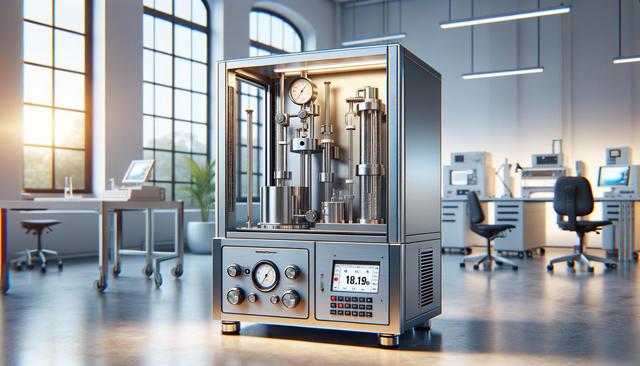Understanding the Principle Behind the Bunsen Ice Calorimeter
The Bunsen Ice Calorimeter operates on a straightforward yet precise principle: the measurement of volume change caused by the melting of ice. When a chemical reaction occurs inside the calorimeter, it either releases or absorbs heat. This heat causes ice surrounding the reaction chamber to melt. As the ice melts, the water produced occupies less volume than the ice, leading to a measurable change in the volume of the enclosed gas. By calculating this volume change, scientists can determine the amount of heat involved in the reaction. This method, though developed in the 19th century, remains a foundational concept in thermochemistry, particularly for reactions that occur at constant pressure.
Key to this method is the assumption that the latent heat of fusion for ice is known and constant. By combining this known value with the observed volume change, researchers can calculate the energy transfer in joules. Despite the advent of modern calorimeters, the Bunsen Ice Calorimeter remains a valuable educational tool for demonstrating the fundamental principles of heat measurement.
Design and Construction of the Calorimeter
The physical design of the Bunsen Ice Calorimeter reflects its functional simplicity and scientific precision. Typically, it consists of a sealed container partially filled with ice, water, and a reaction vessel. The container is connected to a graduated capillary tube or manometer that measures changes in gas volume. This setup is highly sensitive and can detect even small changes in heat energy, making it suitable for laboratory experiments where accuracy is essential.
Some of the essential components include:
- A double-walled container to maintain thermal insulation
- A reaction vessel where the chemical reaction takes place
- A volume measurement device such as a calibrated capillary or manometer
- Ice and water mixture to act as the heat exchange medium
Proper insulation is critical to ensure that external temperature changes do not influence the results. Additionally, the apparatus must be calibrated before use to account for factors such as atmospheric pressure and initial temperature.
Applications in Scientific Research and Education
The Bunsen Ice Calorimeter is widely used in both academic settings and research laboratories to teach and investigate energy changes in chemical reactions. It is particularly effective for exothermic and endothermic reactions where heat exchange can be clearly observed and quantified. In educational institutions, it serves as an excellent tool to introduce students to the laws of thermodynamics and the concept of enthalpy change.
In research, the ice calorimeter is often applied in:
- Studying reaction energetics of specific chemical processes
- Measuring heat capacities of substances
- Evaluating the enthalpy changes in fusion or dissolution experiments
Though modern calorimetry techniques like differential scanning calorimetry (DSC) have taken the lead in high-precision applications, the Bunsen Ice Calorimeter continues to be relevant, especially where simplicity and direct observation of thermal effects are desired.
Advantages and Limitations of the Method
One of the key advantages of the Bunsen Ice Calorimeter is its simplicity and low cost. It does not require complex electronics or advanced software and can be constructed using basic laboratory materials. This makes it accessible for a wide range of users, from high school laboratories to university research facilities. Additionally, its visual nature helps learners grasp abstract thermodynamic concepts more effectively.
However, there are limitations:
- It is not suitable for reactions that occur very rapidly or produce minimal heat changes
- External temperature fluctuations can affect measurement accuracy
- Requires careful calibration and insulation to yield reliable results
Despite these limitations, the Bunsen Ice Calorimeter remains an instructive and functional tool. It is especially valuable in controlled environments where external variables can be minimized.
Modern Relevance and Adaptations
While the Bunsen Ice Calorimeter is a historical device, its principles continue to influence modern calorimetric techniques. Researchers have adapted its basic model to create more sophisticated instruments that utilize digital sensors and automated data collection. These modern versions maintain the core concept of heat measurement through phase changes but offer enhanced precision and usability.
In educational contexts, the calorimeter is often presented in experimental kits that allow students to replicate classic thermodynamic experiments. These kits help build foundational knowledge that can be applied to more complex systems later on. The calorimeter also finds niche uses in materials science and physical chemistry, where understanding minute heat changes is critical.
By appreciating the historical and scientific value of the Bunsen Ice Calorimeter, users can gain a deeper understanding of how energy behaves in chemical systems. Its continued use underscores the enduring nature of well-designed scientific tools.
Conclusion: A Timeless Tool for Thermodynamic Exploration
For students, educators, and researchers alike, the Bunsen Ice Calorimeter offers a tangible way to explore the fundamentals of energy transfer in chemistry. Its simple design and clear results make it an ideal teaching tool, while its scientific accuracy ensures continued relevance in certain research applications. Though it may not match the capabilities of modern calorimeters, its role in laying the groundwork for thermodynamic understanding remains significant. By integrating this classic device into experimental learning, one can bridge historical science with modern exploration.




Leave a Reply